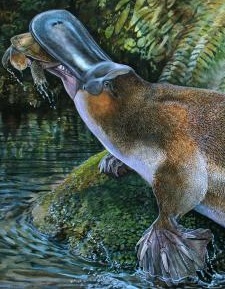Giant platypus adds to skinny family tree
 There are few creatures in the catalogue of nature more peculiar or rare than the platypus, but new research has found it had an ancient, enormous cousin, over five million years ago.
There are few creatures in the catalogue of nature more peculiar or rare than the platypus, but new research has found it had an ancient, enormous cousin, over five million years ago.
A recent finding has added to the range of bizarre elements in the world of the platypus; which sports the only mammalian egg-laying abilities, a snout covered with electro-receptors that detect underwater prey, and a venomous spur on the hind foot of males.
The platypus had been considered to come from a single lineage, with only one species present on the Earth at any time.
The new finding has revealed a side-branch of the platypus’ tree which was occupied by a massive late-Cenozoic species.
The new platypus species, named Obdurodon tharalkooschild, is based on a single tooth found in the famous Riversleigh World Heritage Area of northwest Queensland. While many of Riversleigh's fossil deposits are now being radiometrically dated, the precise age of the particular deposit that produced this giant platypus is likely to be between 15 and 5 million years old.
The name Obdurodon comes from the Greek for “lasting [obdurate] tooth” and was coined to distinguish extinct toothed platypuses from the effectively toothless modern species.
The single tooth has yielded a lot of information, showing the duck-billed beast was probably over a metre long.
“Like other platypuses, it was probably a mostly aquatic mammal, and would have lived in and around the freshwater pools in the forests that covered the Riversleigh area millions of years ago,” said Dr. Suzanne Hand of the University of New South Wales, a co-author of the study.
“Obdurodon tharalkooschild was a very large platypus with well-developed teeth, and we think it probably fed not only on crayfish and other freshwater crustaceans, but also on small vertebrates including the lungfish, frogs, and small turtles that are preserved with it in the Two Tree Site fossil deposit.”
The specific epithet of the new species, tharalkooschild, is a reference to a Dreamtime story about the origin of the platypus.
In the story; Tharalkoo was a head-strong female duck inclined to disobey her parents. Tharalkoo was warned not to swim downriver because Bigoon the Water-rat would have his wicked way with her. Scoffing, she disobeyed her parents and was taken by Bigoon. Tharalkoo escaped and returned to her family, at which point the other ducks were laying eggs, so she did the same. Disconcertingly, instead of a fluffy duckling emerging from her egg, her offspring was a new hybrid with the bill, webbed hind feet, and egg-laying habit of a duck, along with the fur and front feet of a rodent - the first Platypus.
“Discovery of this new species was a shock to us because prior to this, the fossil record suggested that the evolutionary tree of platypuses was relatively linear one,” said Dr. Michael Archer of the University of New South Wales, a co-author of the study.
“Now we realize that there were unanticipated side branches on this tree, some of which became gigantic.”
More details are available from the full report, published here.








 Print
Print